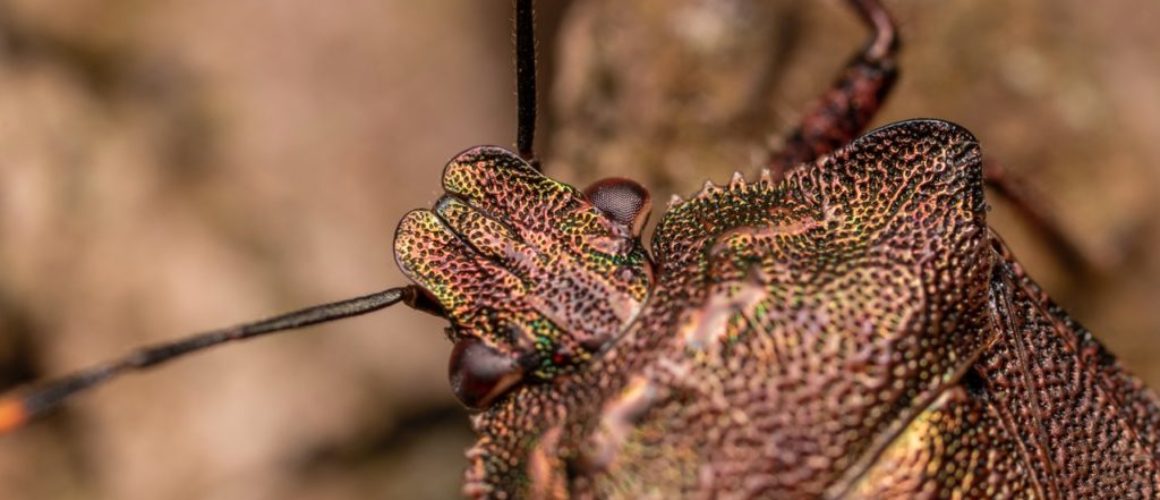The Brown Marmorated Stink Bug is an agricultural pest that, for decades, has wreaked havoc across the globe. Despite being harmless to humans and other animals, these pungent pests are known to reproduce quickly and cause a range of issues. In this article, we will be exploring how to identify stink bugs, how they reproduce and what measures can be taken to prevent and control this pest species.
How to Identify Stink Bugs
Thousands of species of stink bugs exist across the globe, which makes identifying them challenging, but one distinctive feature of the BMSB is their brown shield-shaped body. Once fully grown, these stink bugs will measure around 17mm and have a mottled brown/grey appearance. From underneath the wings, you will notice segments of its abdomen protruding that are often marked with black and white bands. Their darker colour means that it is easy for them to be camouflaged by tree bark, soil and other vegetation, but the younger stink bugs are much more noticeable.
During the first stage of their life, young brown marmorated stink bugs will have much brighter colours, featuring bright red, orange and yellow against black markings. These smaller stink bugs will range between 2-12mm in size, making them difficult to spot and easily mistakable for a ladybug.
BMSB eggs can be difficult to spot as they are well disguised on the underside of leaves. They are usually pale green or white in colour and have a barrel-like shape. One of the easiest ways to tell if they are the eggs of a stink bug is that they are usually laid in groups of 28, and as the embryos grow, you may spot two red eyes.
Finally, one of the easiest ways to tell if you are dealing with a stink bug infestation is the smell. As the name suggests, stink bugs can release an odorous chemical when they are threatened or squashed.
How do stink bugs reproduce?
Stink bugs are notorious for reproducing quickly and regularly and are known to attract potential mates in a couple of ways. Male and female stink bugs will often rub their wings or legs against their body to create a noise that will attract others from the same species. The second way they attract mates is by emitting a unique pheromone that differs from the chemical they are known to release when disturbed.
Once stink bugs have mated, the female will lay between 20 to 30 eggs on the underside of a green plant leaf. Stink bugs are known to lay numerous egg masses throughout the warmer months until September, so it is not unusual to see them on a variety of plants at various stages in the life cycle.
Within five days, these eggs will hatch into nymphs that will aggregate around their eggs during their first stage of life. From this point, it will only take a month for these nymphs to develop into fully grown adults capable of reproducing.
Stink bug Prevention and Control measures
There are some simple steps you can take to deter stink bugs, such as:
- Reducing Outdoor Lighting
- Fix cracks and holes around the property that stink bugs can use to crawl inside
- Checking bags that are being brought in from outside
- Fix water pipes
- Remove sources of food
Simple steps such as these can effectively deter stink bugs, but, unfortunately, they exist year-round, and if you do find an infestation, it is vital that you address the problem as soon as possible.
Before a stink bug infestation can get worse, it is always advisable to seek out the services of a licenced, professional pest control fumigation service to assess and evaluate the problem. Stink bugs not only threaten the agricultural industry but can also cause damage to ornamental plants, home gardens and more.
Using a pressurised gas fumigant called Sulfuryl Flouride, stink bugs such as the brown marmorated stink bug can be quickly and safely eliminated. Alongside Heat Treatments, this method is regularly used as a means of pest control to rid properties, warehouses, cargo, containers and other sites of unwanted guests.
Urban Hawks Fumigation Services
Urban Hawks is proud to offer our Fumigill Fumigation Services and treatments for The Brown Marmorated Stink Bug for clients throughout the UK. If you are concerned about Brown Marmorated Stink Bugs on your cargo or have any questions, please don’t hesitate to contact our team on 01513456854 or email us at info@urbanhawks.co.uk.

